We found ourselves in Warsaw airport
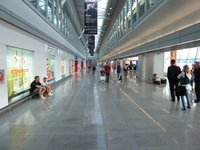 with recycling bins
with recycling bins
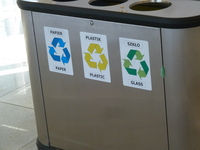 and a blurry sign in English
and a blurry sign in English
 with a clearer one in Polish though the agent would tell us there was a delay but wouldn't tell us why or when
with a clearer one in Polish though the agent would tell us there was a delay but wouldn't tell us why or when
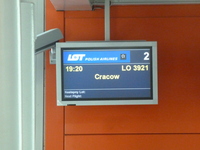 though we eventually made it onto the plane
though we eventually made it onto the plane
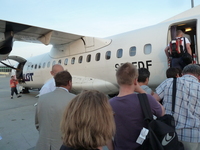
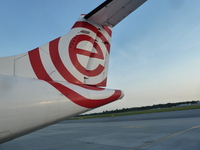 and got our edible bar
and got our edible bar
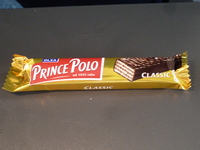 before getting to the other side and watching our baggage roll down the conveyor
before getting to the other side and watching our baggage roll down the conveyor
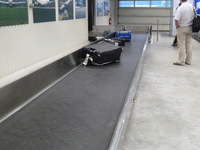 so that we could catch the taxi to our hotel and pass this large hotel
so that we could catch the taxi to our hotel and pass this large hotel
 before we arrived
before we arrived
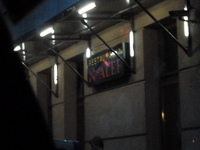 and found our way to the room where the beds were typical
and found our way to the room where the beds were typical

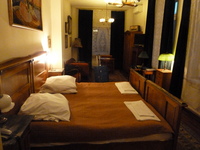 but the room was vase and the walls were covered with artwork
but the room was vase and the walls were covered with artwork
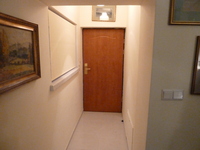
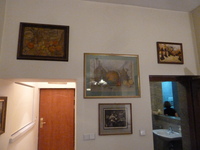
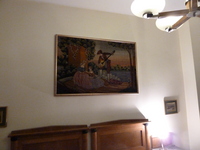
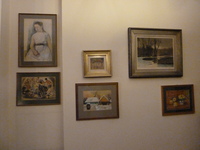 and the bathroom looked good (and more so in the morning when we realized how wonderful the shower was).
and the bathroom looked good (and more so in the morning when we realized how wonderful the shower was).
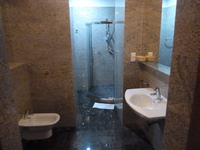
We walked out to the horoscope restaurant down the street
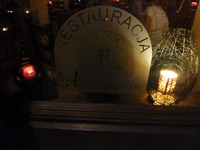 and ordered beer some of which was served with a straw because of the added raspberry juice
and ordered beer some of which was served with a straw because of the added raspberry juice
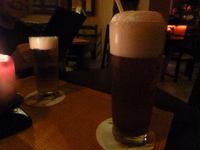 and noted the beer coasters
and noted the beer coasters
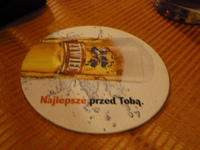 as a pate came to welcome us
as a pate came to welcome us
 and was illuminated
and was illuminated
 before Suzanne's potato pancakes
before Suzanne's potato pancakes
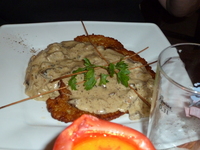 and my pierogies arrived
and my pierogies arrived
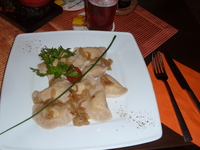 accompanied by this spinach dish for Suzanne.
accompanied by this spinach dish for Suzanne.
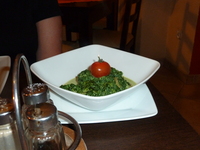 The waitress talked us into this dessert where the bird's nest was actually narrow strands of caramel
The waitress talked us into this dessert where the bird's nest was actually narrow strands of caramel
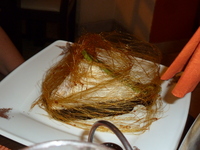 and then the bill came
and then the bill came
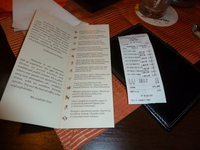 and I took a picture of the waitress with Suzanne before
and I took a picture of the waitress with Suzanne before
 we took the obligatory phone booth photo and called it a night.
we took the obligatory phone booth photo and called it a night.
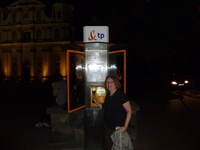
The next morning I had a chance to observe the various views from our room
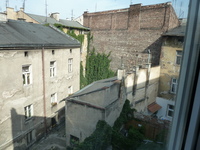
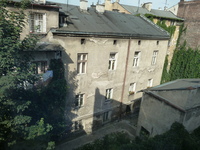
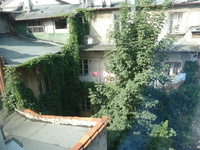
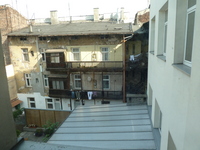 before we went down for breakfast and I filled my plate
before we went down for breakfast and I filled my plate
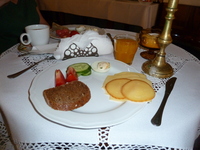 as Suzanne filled hers
as Suzanne filled hers
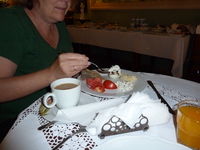 and she
and she
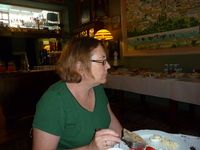 and I posed for portraits
and I posed for portraits
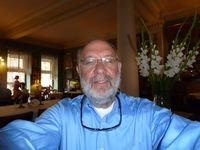 before I explored and found signs for the hotel on their patio.
before I explored and found signs for the hotel on their patio.
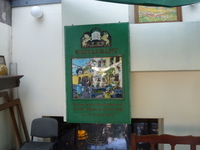
 We greeted Mitch, Kathleen and Liam
We greeted Mitch, Kathleen and Liam
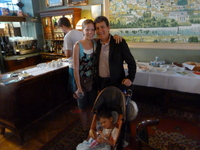 before being introduced to the group and walking through our neighborhood
before being introduced to the group and walking through our neighborhood
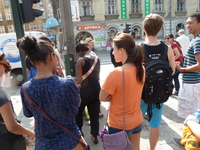
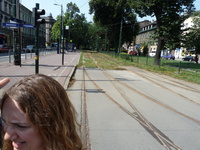
 until we arrived at the gift shop
until we arrived at the gift shop
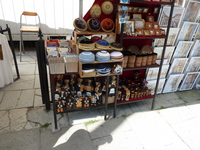 outside the Remuh Synagogue
outside the Remuh Synagogue
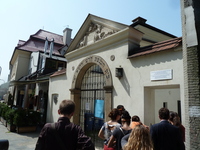 and we made our way past the memorials
and we made our way past the memorials
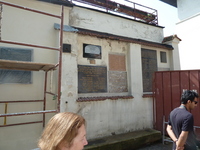
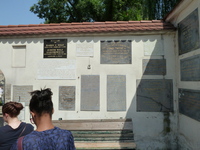 into the sanctuary
into the sanctuary
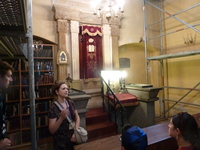
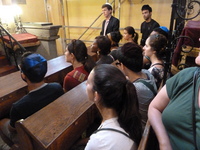 with the bemah in the middle
with the bemah in the middle
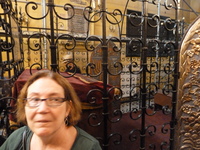 and the ark with Torah scrolls
and the ark with Torah scrolls
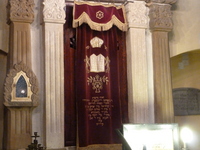 and a poster above the bemah giving the words to the aliyah
and a poster above the bemah giving the words to the aliyah
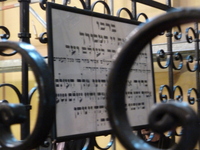 as we left the bemah
as we left the bemah
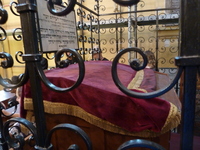 and headed to the cemetery where we saw the grave stone of the famous Rebe complete with notes left and stones of visitors
and headed to the cemetery where we saw the grave stone of the famous Rebe complete with notes left and stones of visitors
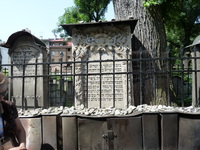
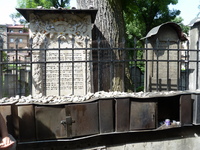
 and then explored the tombstones as
and then explored the tombstones as

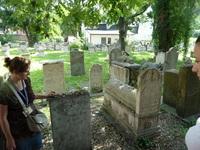
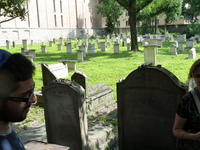 as our guide focused on our tombstone and explained the significance of what was written on it
as our guide focused on our tombstone and explained the significance of what was written on it
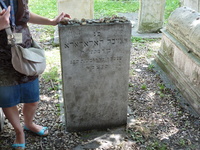 and we then made our way through the cemetery
and we then made our way through the cemetery
to the wall that was constructed of pieces of gravestones that had been broken by the Nazis. Note that the Nazis made no attempt to destroy the cemetery; instead they used it as a garbage dump because they knew this would be more insulting to the Jews.
|
At the wall, I took some broad photos of the whole cemetery
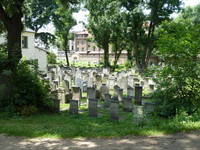

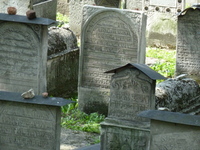 and then saw some pieces of stones corresponding to Kahanim (and hence the hands).
and then saw some pieces of stones corresponding to Kahanim (and hence the hands).
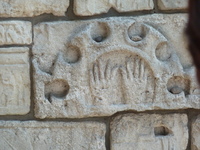
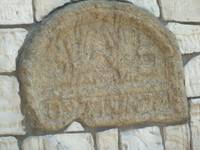 on the way out, I recorded this sad memorial
on the way out, I recorded this sad memorial
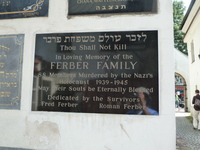 and we headed to the town's memorial to the Jews who had perished
and we headed to the town's memorial to the Jews who had perished

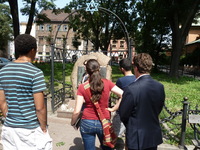 and the square (which is now filled with shops and restaurants largely owned by non-Jews)
and the square (which is now filled with shops and restaurants largely owned by non-Jews)
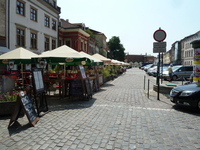 and the synagogue
and the synagogue
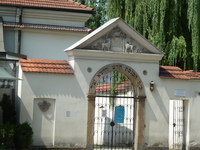 before capturing a final shot of the memorial
before capturing a final shot of the memorial
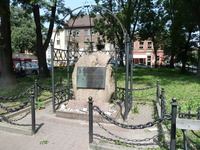 and heading across the river to this plaza where the chairs had a special significance as I was to learn
and heading across the river to this plaza where the chairs had a special significance as I was to learn
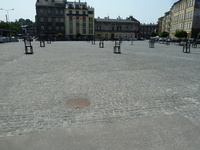 but first I noted this street scene which was the location of the resistance
but first I noted this street scene which was the location of the resistance
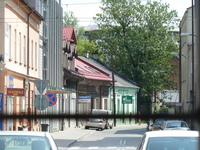 as our group came onto the square which was at the heart of the ghetto
as our group came onto the square which was at the heart of the ghetto

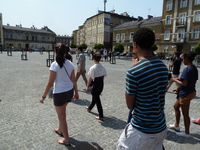 as we left this structure which had served as the police station for the Nazis who oversaw the ghetto
as we left this structure which had served as the police station for the Nazis who oversaw the ghetto
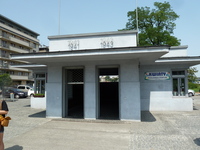 and it was here that I learned that the chairs were an art installation dedicated to those who had been killed by the Nazis
and it was here that I learned that the chairs were an art installation dedicated to those who had been killed by the Nazis

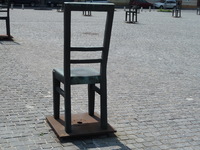 and we then walked down the street
and we then walked down the street
 and took the obligatory phone booth picture
and took the obligatory phone booth picture
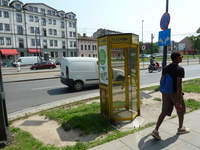 before we came to this sign
before we came to this sign
 defining the ghetto wall which had been made to look like tombstones to signify tot he Jews that this was their end.
defining the ghetto wall which had been made to look like tombstones to signify tot he Jews that this was their end.
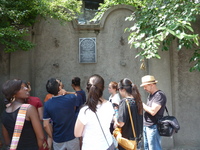

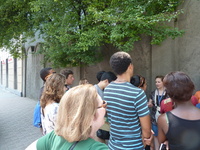 We were also shown windows that were bricked over as they were on buildings that were part of the ghetto and so could not have views to the outside
We were also shown windows that were bricked over as they were on buildings that were part of the ghetto and so could not have views to the outside
 and as we walked
and as we walked
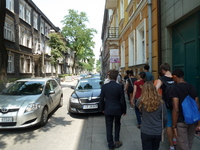 this sign seemed like an odd juxtaposition of the past and the present (or future)
this sign seemed like an odd juxtaposition of the past and the present (or future)
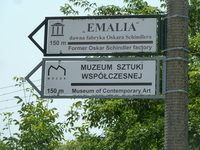 and so we made our way to Oskar Schindler's factory
and so we made our way to Oskar Schindler's factory
 and saw the names of those he had saved
and saw the names of those he had saved

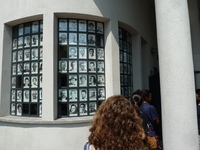
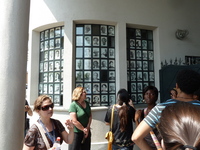 before entering the museum
before entering the museum
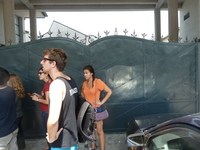 noting the price guide
noting the price guide
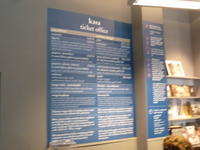 and having some water, it being a hot day,
and having some water, it being a hot day,
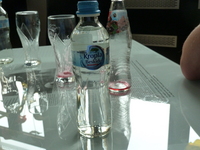 and seeing the kosher statement (which had just expired) for the coffee.
and seeing the kosher statement (which had just expired) for the coffee.
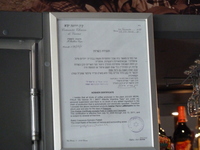
The museum traced the history of Poland and Krakow through the war beginning in 1939
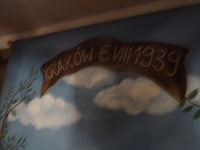 as our tour guide explained the premise which we didn't grasp for a few rooms.
as our tour guide explained the premise which we didn't grasp for a few rooms.
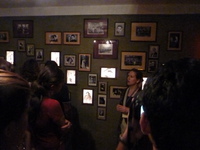 We began with war gear
We began with war gear
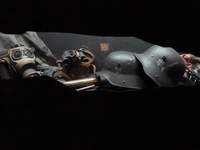 and uniforms
and uniforms
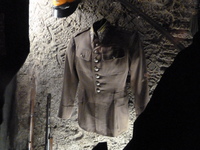 and then observed the German occupation
and then observed the German occupation
 which caused Nazi flags to be hung everywhere
which caused Nazi flags to be hung everywhere

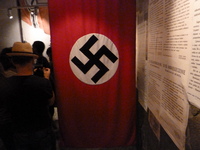 and statues to be destroyed, though part of this one was hidden
and statues to be destroyed, though part of this one was hidden
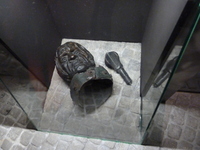 as this poster explained the situation
as this poster explained the situation
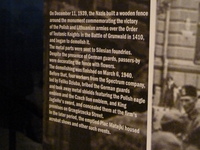 and we saw the first sign of Jewish rights being taken away
and we saw the first sign of Jewish rights being taken away
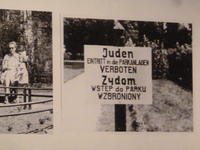 as we observed the trolley car
as we observed the trolley car
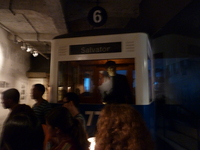 and heard about the professors at the local university being removed from their positions in an anti-intellectual campaign
and heard about the professors at the local university being removed from their positions in an anti-intellectual campaign
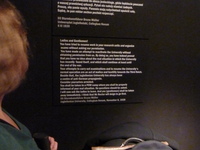 as the Nazis took control as we noted by the floor
as the Nazis took control as we noted by the floor
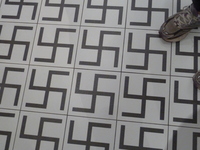
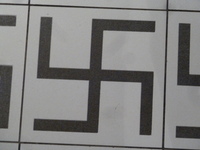
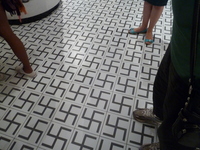 and wall decorations
and wall decorations
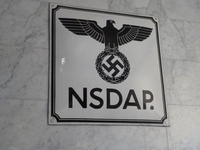 as Mitch and Alice stood on the frightening floor
as Mitch and Alice stood on the frightening floor
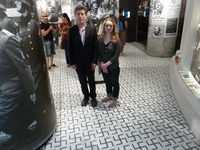 and we saw newsreels of the Nazis in power
and we saw newsreels of the Nazis in power
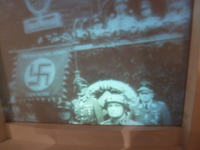
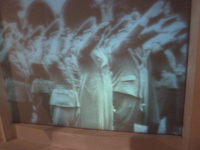 and as we passed this sign
and as we passed this sign
 we read about the Jews being displaced
we read about the Jews being displaced
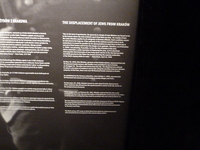
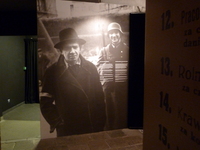 with sentences being carried out
with sentences being carried out
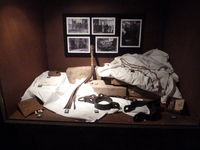

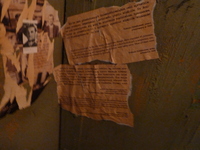 and arm patched being worn
and arm patched being worn
 with the wall being constructed even as Passover was being celebrated
with the wall being constructed even as Passover was being celebrated
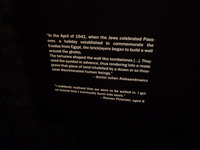 and visions of those who had faded from sight.
and visions of those who had faded from sight.
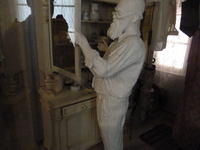
Next we saw the pots that Schindler's factory had made
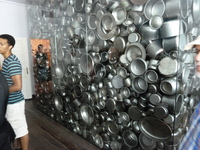 with the names of those he had saved
with the names of those he had saved
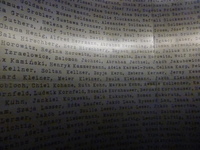
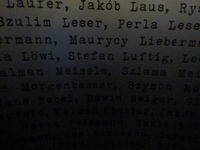 and the map over his desk
and the map over his desk
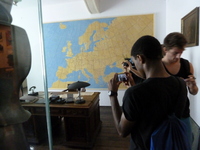 but the war effort was not going well for the Nazis
but the war effort was not going well for the Nazis
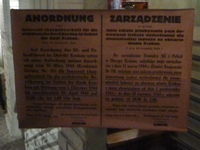 and these were the gifts possible for the last Christmas of the occupation
and these were the gifts possible for the last Christmas of the occupation

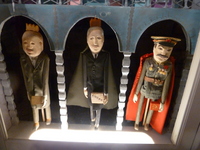
 but then Stalin took over and things didn't improve enough.
but then Stalin took over and things didn't improve enough.
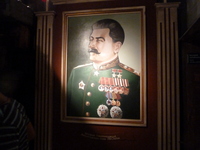
We were then escorted to a room that talked about choices
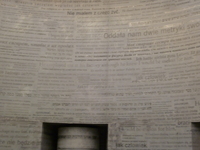

 and another that defined various attributes before leaving the museum.
and another that defined various attributes before leaving the museum.
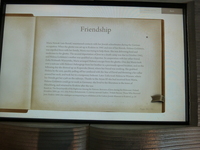 On the way back to town, we crossed this bridge that gave both air and road surface temperatures
On the way back to town, we crossed this bridge that gave both air and road surface temperatures
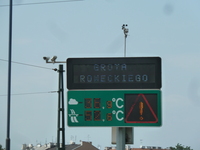 before we headed to the zapiekanka stand
before we headed to the zapiekanka stand
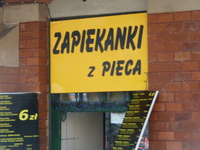 where we saw pigeons
where we saw pigeons
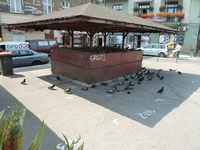 before approaching the stand
before approaching the stand
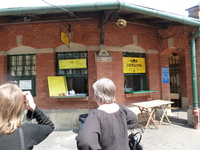 and choosing from a menu
and choosing from a menu
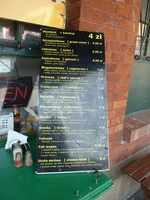
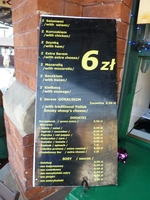 first a vegetarian
first a vegetarian
 and then a standard
and then a standard
 which I recorded as I ate
which I recorded as I ate
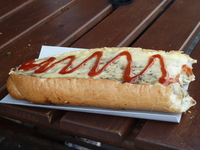
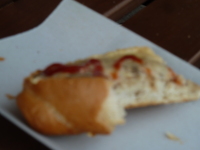
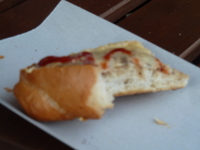 and after noting the the Gallerie d' Art Naif was closed
and after noting the the Gallerie d' Art Naif was closed
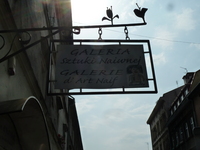 we purchased some liquids and came home.
we purchased some liquids and came home.
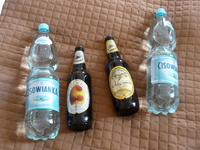
After a rest, we went out for the group dinner with special menu
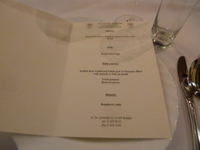
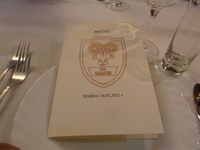 and before we ate, Tess sang opera for us
and before we ate, Tess sang opera for us
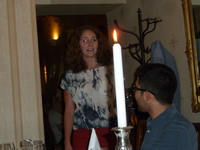 and then steak tartare arrived
and then steak tartare arrived
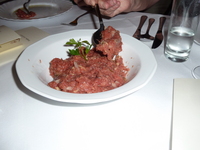 with bread
with bread
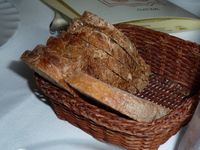 salad
salad
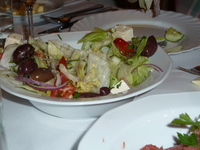 and salmon.
and salmon.
 Next came the soup
Next came the soup
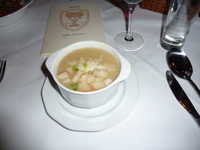 followed by the main courses of duck
followed by the main courses of duck
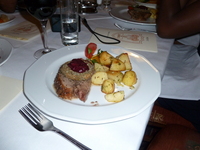 sole
sole
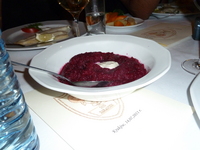 and pancakes
and pancakes
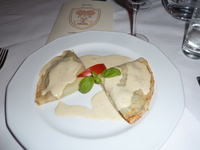 with beets
with beets
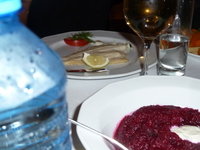 and followed by a dessert of raspberry cake.
and followed by a dessert of raspberry cake.
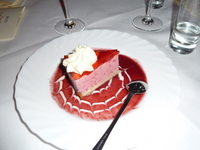
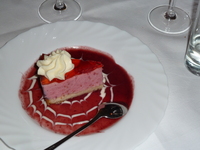
After saying hello to Barry the videographer, we decided to call it a night.

Friday began with breakfast


 including scrambled eggs for Suzanne
including scrambled eggs for Suzanne
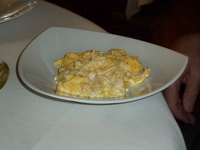 before we said good-bye (and actually hello and good bye in my case) to Ben Ravid who is an expert on the Venice ghetto and had joined the group there and then continued on to Poland on his own. We also saw Ben's wife but I forget her name.
before we said good-bye (and actually hello and good bye in my case) to Ben Ravid who is an expert on the Venice ghetto and had joined the group there and then continued on to Poland on his own. We also saw Ben's wife but I forget her name.
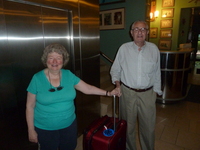 We went off on a walking tour through town starting at the place where the students take their Polish lessons
We went off on a walking tour through town starting at the place where the students take their Polish lessons
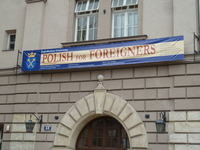 and then capturing views of the Wawel Castle
and then capturing views of the Wawel Castle
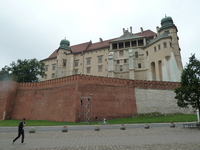
 as Suzanne posed with Mikhail, our guide.
as Suzanne posed with Mikhail, our guide.
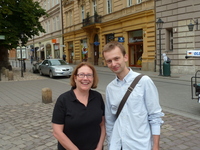 After this church (of which there are many famous ones in Krakow)
After this church (of which there are many famous ones in Krakow)
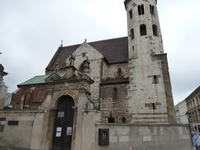
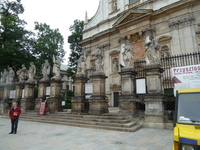
 Mikhail pointed out these symbols which were used instead of street addresses in early Krakow
Mikhail pointed out these symbols which were used instead of street addresses in early Krakow
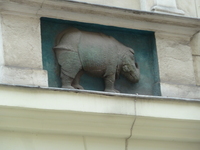
 so that e.g. Ara would be described as being at the elephant.
so that e.g. Ara would be described as being at the elephant.
 After one more animal address,
After one more animal address,
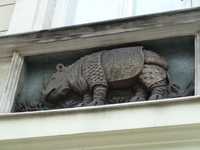 we saw replicas of the stained glass windows that make St. Francis' Church so famous
we saw replicas of the stained glass windows that make St. Francis' Church so famous
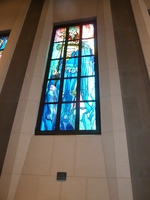
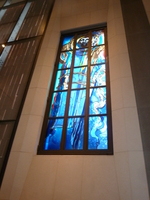
 and then we continued on to the main square and cloth hall
and then we continued on to the main square and cloth hall

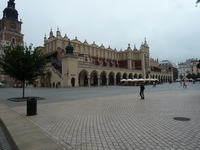 where we noticed the water pump
where we noticed the water pump
 the 10th century church
the 10th century church
 the curious sculpture
the curious sculpture
 and the tower
and the tower
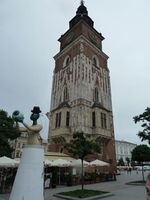 before heading to the Collegium Maius -- the oldest part of the Jagiellonskie University
before heading to the Collegium Maius -- the oldest part of the Jagiellonskie University
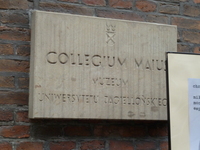 and we observed from the outside
and we observed from the outside
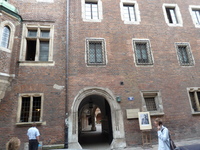
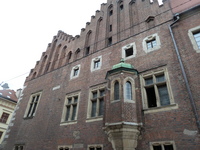
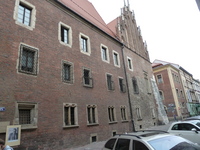
 before making our way into the courtyard
before making our way into the courtyard
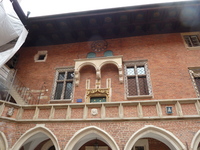 where we admired the gutters
where we admired the gutters
 the architecture
the architecture
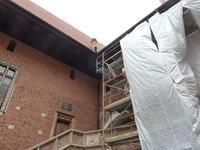 and saw the face that tells if you've told a lie
and saw the face that tells if you've told a lie

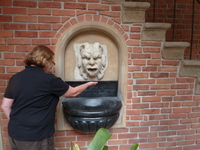 and, if so, eats your hand which fortunately did not happen to Suzanne
and, if so, eats your hand which fortunately did not happen to Suzanne
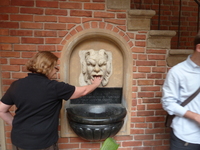 as we went through the green door
as we went through the green door
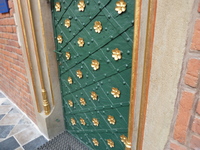 to an amazing painting
to an amazing painting
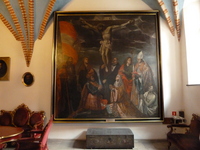 and an impressive ceiling
and an impressive ceiling
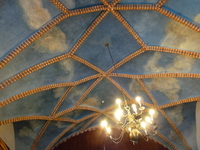 as we looked ahead to the busts
as we looked ahead to the busts
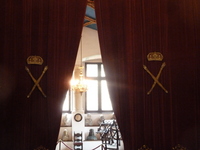 and back to the famous professors who would perform when the clock struck 11 (we unfortunately were not around to see their performance)
and back to the famous professors who would perform when the clock struck 11 (we unfortunately were not around to see their performance)
 and then made our way in and admired some famous attendees
and then made our way in and admired some famous attendees
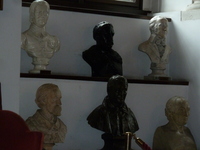 including Copernicus
including Copernicus
 and as we passed through
and as we passed through

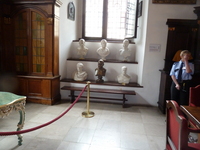 we entered the cabinet room which is still used for gatherings
we entered the cabinet room which is still used for gatherings

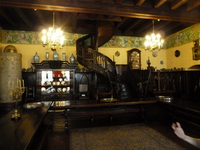 and saw this status of Kazmierz
and saw this status of Kazmierz
 as we moved
as we moved
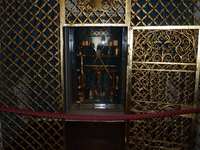 and saw a model of male anatomy (missing a few pieces)
and saw a model of male anatomy (missing a few pieces)
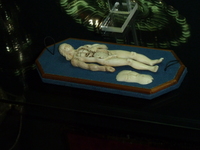 as well as a pocket watch (for large pockets)
as well as a pocket watch (for large pockets)
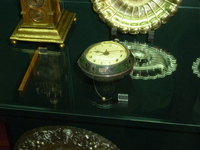 and we then saw a professor's quarters though they were designed in a different era when professors were celibate and lived a monk like existence,
and we then saw a professor's quarters though they were designed in a different era when professors were celibate and lived a monk like existence,
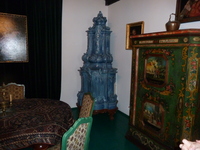
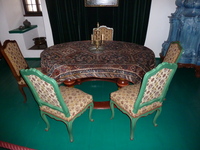 we then made our way past portraits of some of the notables
we then made our way past portraits of some of the notables
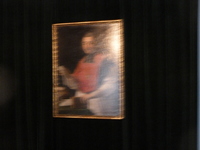
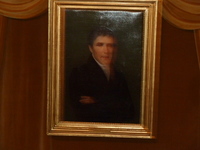 to the globe of 1510 (or a replica thereof) which had North America at the south pole.
to the globe of 1510 (or a replica thereof) which had North America at the south pole.
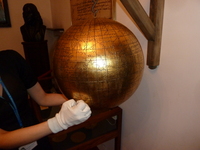 We were shown proof that Copernicus had attended the University though there is no record of him having graduated
We were shown proof that Copernicus had attended the University though there is no record of him having graduated
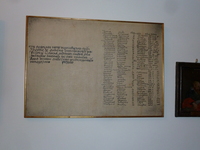 and shown a copy of his original manuscript
and shown a copy of his original manuscript
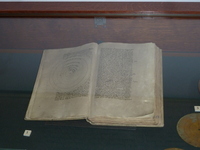 and his tools
and his tools
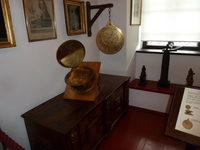
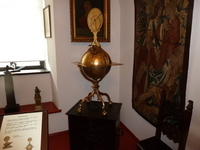 before being led into the faculty room
before being led into the faculty room
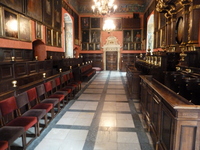 with the portraits of all the faculty on the wall
with the portraits of all the faculty on the wall
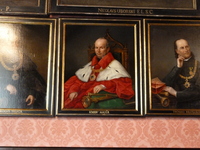 and amazing workmanship.
and amazing workmanship.
 Next we saw a portrait of the most famous Pole who received his degree here (and an honorary degree to boot)
Next we saw a portrait of the most famous Pole who received his degree here (and an honorary degree to boot)
 and made our way through this remarkable door
and made our way through this remarkable door
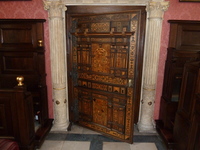 into the green room
into the green room
 with the impressive ceiling
with the impressive ceiling
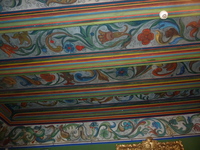 and artwork
and artwork
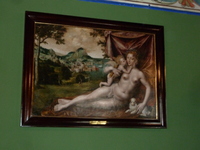
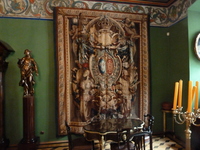 a player piano gifted by Chopin
a player piano gifted by Chopin
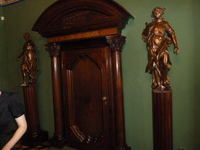 and an impressive floor
and an impressive floor
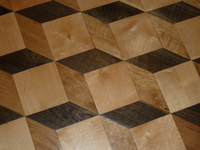 before Suzanne and I posed with our tour guide
before Suzanne and I posed with our tour guide
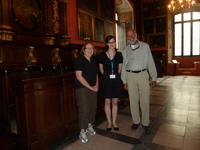 as did Mikhail
as did Mikhail
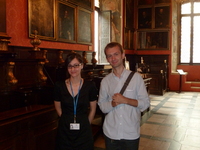 and we thanked the guard who had opened doors for us
and we thanked the guard who had opened doors for us
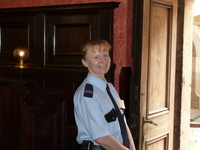 before we ventured out again
before we ventured out again
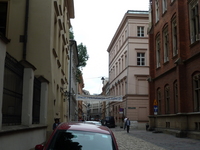 and saw the administration building here the horrible meeting was held at which the faculty were led off to the death camp
and saw the administration building here the horrible meeting was held at which the faculty were led off to the death camp
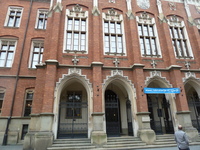 and then made our way
and then made our way
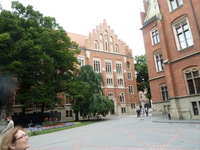 past the historical markers
past the historical markers
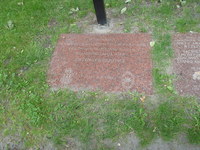
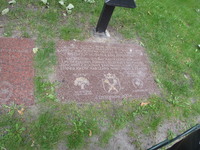 and the status
and the status
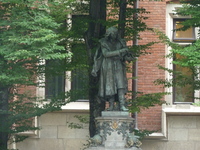 to the window where the pope looked out on the citizens when he visited his town
to the window where the pope looked out on the citizens when he visited his town
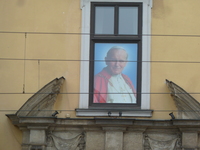 and we ran into Mitch and Alice as we made our way back
and we ran into Mitch and Alice as we made our way back
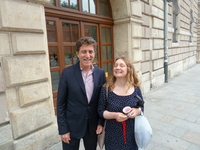 to the bus
to the bus
 to begin our journey through the pleasant countryside to a most unpleasant site.
to begin our journey through the pleasant countryside to a most unpleasant site.
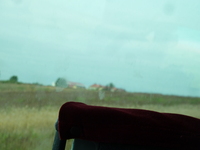 Barry took much video
Barry took much video
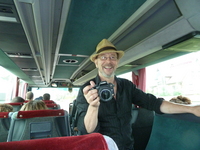 as I noted this road sign (whose meaning Google interprets ''second strong transition road'')
as I noted this road sign (whose meaning Google interprets ''second strong transition road'')
 and missed
and missed
 when first I tried to get the sign showing the way to Oswiecim, the Polish town by Auschwitz.
when first I tried to get the sign showing the way to Oswiecim, the Polish town by Auschwitz.
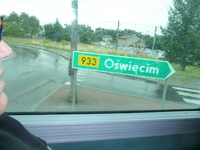 I changed my battery
I changed my battery
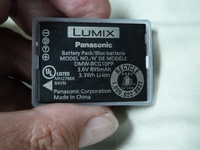 for the anticipated Muzeum at Auschwitz
for the anticipated Muzeum at Auschwitz
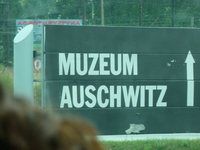 but first we stopped in the town
but first we stopped in the town
 and made our way to the Jewish Museum
and made our way to the Jewish Museum
 where we saw images
where we saw images
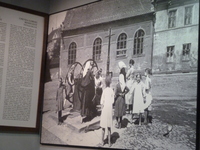 and read stories
and read stories
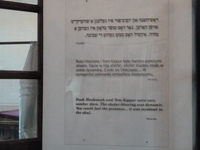
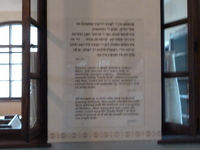
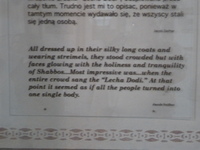
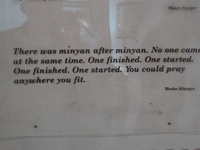 before entering the room that was the sanctuary though none of the original pieces survived the Nazi occupation and though the town was 50% Jewish (7000 of 14,000), there are no Jews there now and so they can only raise a minyan when visitors come.
before entering the room that was the sanctuary though none of the original pieces survived the Nazi occupation and though the town was 50% Jewish (7000 of 14,000), there are no Jews there now and so they can only raise a minyan when visitors come.
|
Next we stopped at a hotel where Catholics often stay when visiting Auschwitz. It is intended to establish a dialog among religions particularly Catholics and Jews given the demographics of Poland, then and now
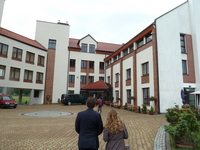 and we ate soup without broth
and we ate soup without broth
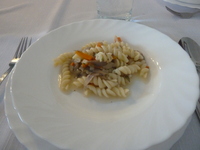 and with
and with
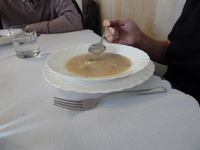 and had vegetables with fish (without for some)
and had vegetables with fish (without for some)
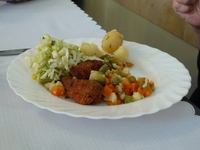 and potatoes
and potatoes
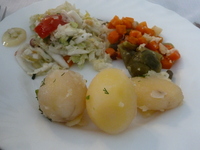 before making our way to Auschwitz
before making our way to Auschwitz
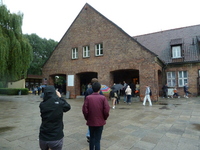 and through the visitors center
and through the visitors center
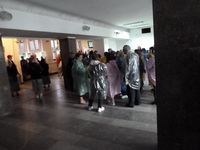 past the Arbeit Macht Frei gate
past the Arbeit Macht Frei gate
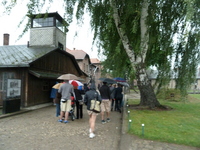
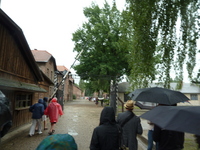
 and onto the actual grounds of the camp
and onto the actual grounds of the camp
|
where we first visited this building intended to give us the background
 of where people came from to Auschwitz
of where people came from to Auschwitz
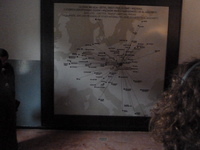 and their numbers
and their numbers
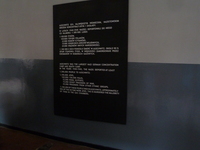 along with some of the horrible rationale that was used to justify the place.
along with some of the horrible rationale that was used to justify the place.
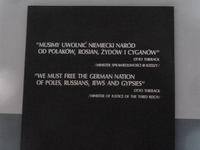
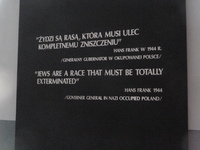 We watched people arrive
We watched people arrive
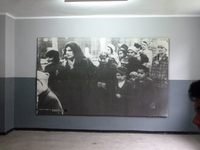 saw this memorial
saw this memorial
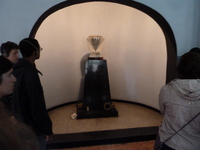 and read some of the history
and read some of the history
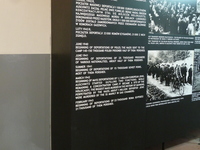
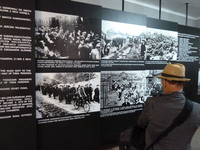
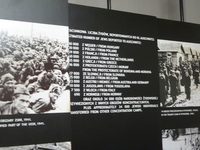
 and saw the Jews leaving various transit camps and ghettos
and saw the Jews leaving various transit camps and ghettos
|
and then observed their arrival where it was decided if they would live under horrible conditions of be killed within 20 minutes
 as we revisited the state borders at the time
as we revisited the state borders at the time
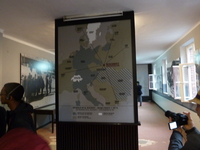 watched families arrive
watched families arrive
 and heard the tale people were told on arrival to get them into the gas chambers
and heard the tale people were told on arrival to get them into the gas chambers
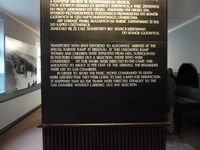 and observed a model of an actual crematorium.
and observed a model of an actual crematorium.
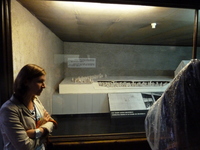
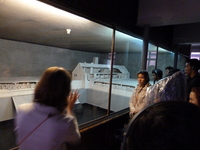 These were the canisters that he;d the poisonous gas
These were the canisters that he;d the poisonous gas
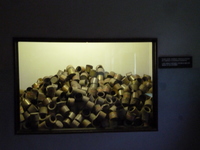 this was the scale of the operation
this was the scale of the operation
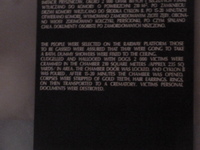 and these were individual pellets that killed.
and these were individual pellets that killed.
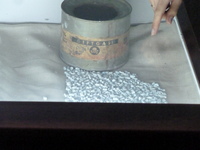 Personal affects were gathered as were these eye glasses
Personal affects were gathered as were these eye glasses
 these tallises
these tallises
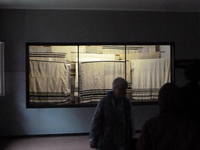
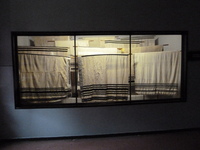 these prosthetics
these prosthetics
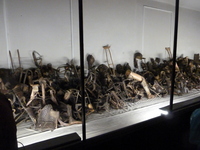 these pots and pans (since people thought they were being relocated)
these pots and pans (since people thought they were being relocated)
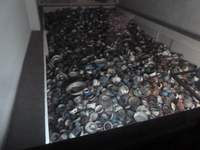 the luggage they brought
the luggage they brought
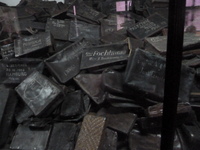
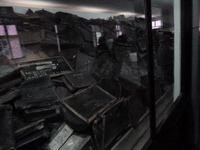 toys for the children
toys for the children
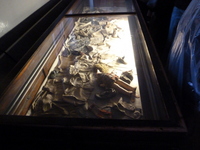 and shoes
and shoes
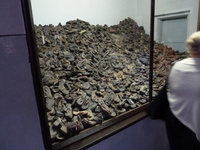
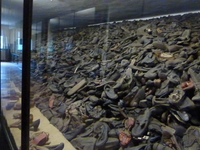
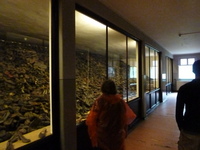 as the rain fell outside and the day was dark as was appropriate for our tour.
as the rain fell outside and the day was dark as was appropriate for our tour.
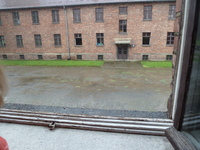
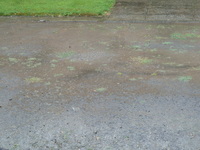 Next we were shown barracks that housed up to 1000 people
Next we were shown barracks that housed up to 1000 people
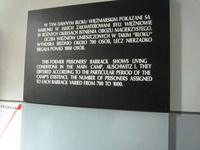 with photos of those interred until the cost of photography became too great and so numbers were tattooed on arms to track prisoners
with photos of those interred until the cost of photography became too great and so numbers were tattooed on arms to track prisoners
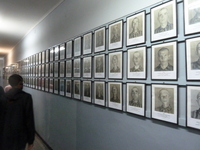 and initial sleeping conditions which was hay on floors
and initial sleeping conditions which was hay on floors
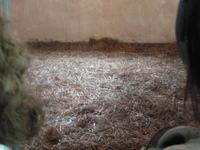 with this row of sinks which could be used for few minutes per day per person
with this row of sinks which could be used for few minutes per day per person
 and this describes
and this describes
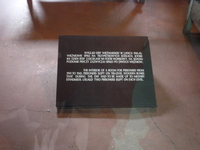 the later (more improved) sleeping arrangements.
the later (more improved) sleeping arrangements.
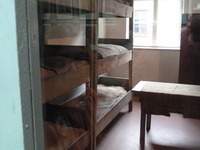 Needless to say the living conditions were horrible
Needless to say the living conditions were horrible
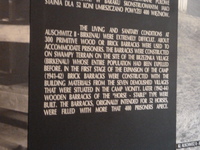 as were these structures onto which prisoners crowded.
as were these structures onto which prisoners crowded.
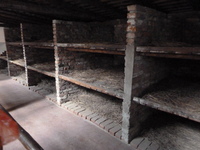 Next we made our way
Next we made our way
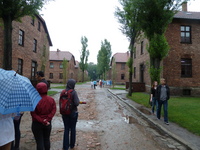 and saw the guards' box
and saw the guards' box
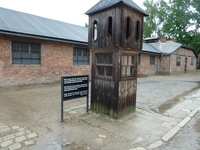 where the SS officer in charge would stand if it was raining and there were escapees and so the prisoners had to stand outside for as long as 21 hours until the escapees returned (or were killed)
where the SS officer in charge would stand if it was raining and there were escapees and so the prisoners had to stand outside for as long as 21 hours until the escapees returned (or were killed)
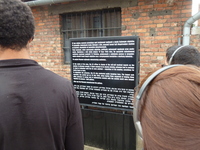 and we saw the gallows
and we saw the gallows
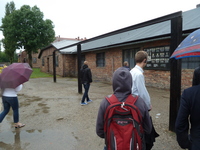 where those involved in escapes (including this group) were hung
where those involved in escapes (including this group) were hung
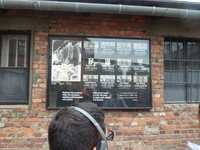 and we made our way past the barbed wire fences
and we made our way past the barbed wire fences
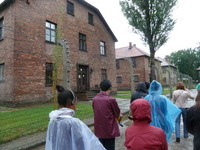
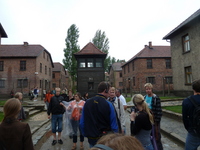 to the place where the first commandant was hung after the war.
to the place where the first commandant was hung after the war.
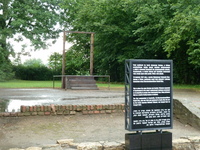 Next we made our way into the actual gas chambers. At this spot you removed your clothes.
Next we made our way into the actual gas chambers. At this spot you removed your clothes.
 and went into what you thought was a shower room
and went into what you thought was a shower room
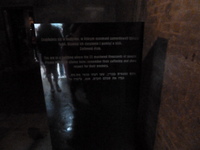 but many were killed there and must be respected
but many were killed there and must be respected
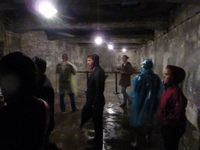 for a guard dropped pellets through holes like this in the roof which killed everyone in the room
for a guard dropped pellets through holes like this in the roof which killed everyone in the room
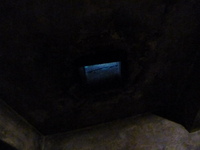 and then the bodies were placed in ovens such as these to be reduced to ashes which were used to fertilize the soil.
and then the bodies were placed in ovens such as these to be reduced to ashes which were used to fertilize the soil.

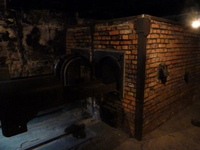 We walked away from the train tracks at Auschwitz 1
We walked away from the train tracks at Auschwitz 1

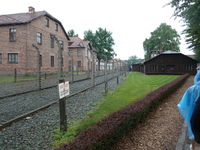
 and went to Auschwitz 2 -- Birkenau which was designed to kill many more people
and went to Auschwitz 2 -- Birkenau which was designed to kill many more people
 as the grounds were enormous
as the grounds were enormous
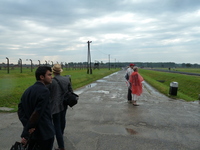
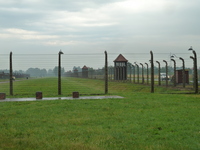
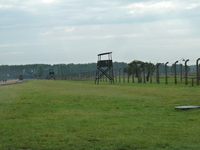
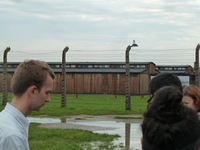 and more primitive
and more primitive
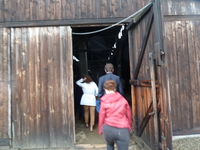 as you can see from the beds on which people slept
as you can see from the beds on which people slept
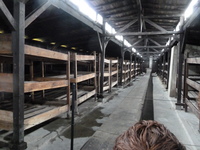
 in a massive room that had previously been a barn
in a massive room that had previously been a barn
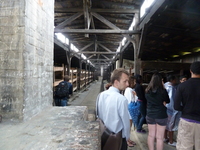 which housed 52 horses and now was housing 400 prisoners.
which housed 52 horses and now was housing 400 prisoners.
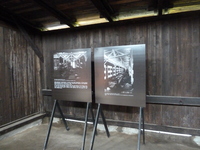 Next we saw the bathroom facilities
Next we saw the bathroom facilities
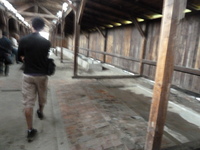 where the toilet were unsanitary, not private and of use for very limited time.
where the toilet were unsanitary, not private and of use for very limited time.
 Finally we climbed up into the tower so that we could see just how massive the camp was.
Finally we climbed up into the tower so that we could see just how massive the camp was.
|
and then I noted the barbed wire keeping prisoners in
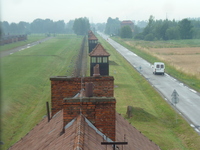 and that this has been named a world heritage site so that all will know what happened here.
and that this has been named a world heritage site so that all will know what happened here.
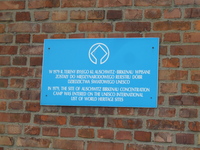 After a few more photos from outside noting the vastness
After a few more photos from outside noting the vastness
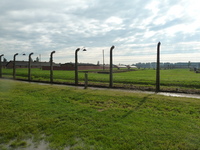
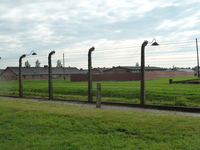
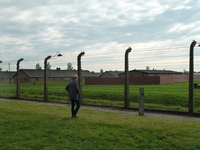 we headed back to Krakow where I said good bye (though this would happen again) to Barry and his wife
we headed back to Krakow where I said good bye (though this would happen again) to Barry and his wife
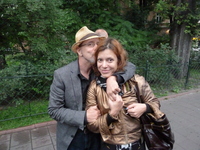 and we got some food for a snack before dinner.
and we got some food for a snack before dinner.
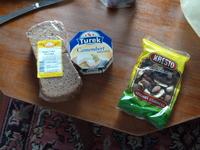 Then we went out to dinner and had borscht
Then we went out to dinner and had borscht
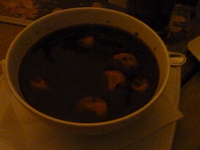 and hummus (along with pierogies)
and hummus (along with pierogies)
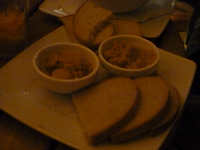 and the borscht was too pretty to not record.
and the borscht was too pretty to not record.
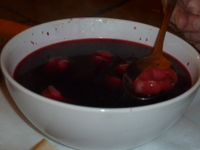
The next morning, we ran into Mitch, Barry and Gregory after breakfast as Mitch was preparing to do one final interview
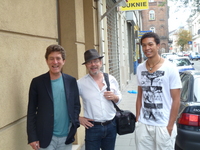 and I recorded a page of the menu at the Alef Restaurant at the hotel where we are staying
and I recorded a page of the menu at the Alef Restaurant at the hotel where we are staying
 before we recorded our distances to many points on the globe
before we recorded our distances to many points on the globe
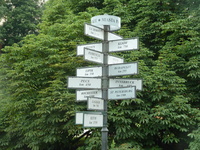
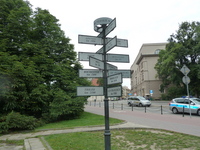
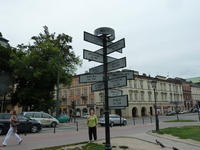
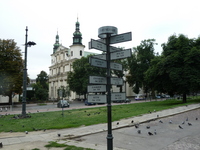 and took a quick look at the Wawel Castle and Cathedral that we'd be seeing later
and took a quick look at the Wawel Castle and Cathedral that we'd be seeing later
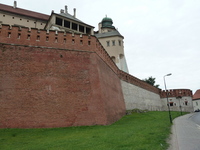
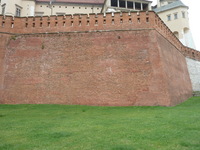 as we made our way down what is thought to be the oldest street in Krakow (though by day's end we had heard about Prince Krak who killed the dragon and I doubt that it was on this street)
as we made our way down what is thought to be the oldest street in Krakow (though by day's end we had heard about Prince Krak who killed the dragon and I doubt that it was on this street)
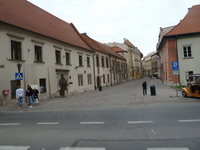 and noticed that because the pope had lived on this street, there were various markers of this
and noticed that because the pope had lived on this street, there were various markers of this
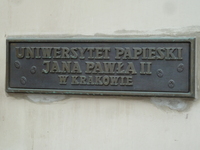
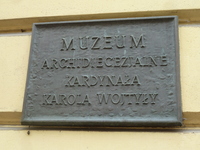
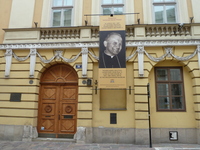 along with the interesting facades we saw
along with the interesting facades we saw
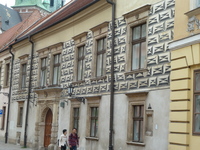 and I was able to get an excellent of the church of St. Peter and Paul to which I was too close yesterday
and I was able to get an excellent of the church of St. Peter and Paul to which I was too close yesterday
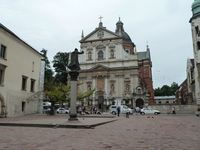 and the fountain there
and the fountain there
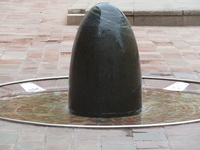 before we made our way to the Main Square and noted the Cloth Hall
before we made our way to the Main Square and noted the Cloth Hall
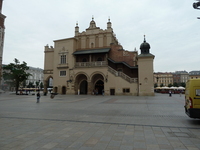 and this model of the town hall tower
and this model of the town hall tower
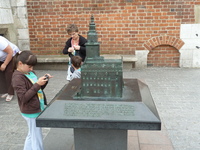 with explanation
with explanation
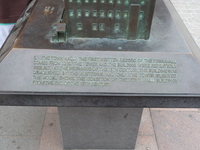 before I recorded the tower itself (by walking back quite a distance)
before I recorded the tower itself (by walking back quite a distance)
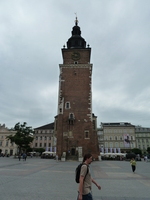 and a side view of the cloth hall
and a side view of the cloth hall
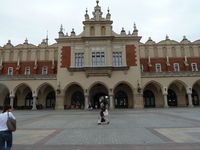 and then we took on the sculpture
and then we took on the sculpture
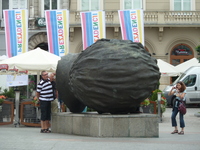
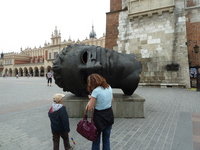 by the local sculptor
by the local sculptor
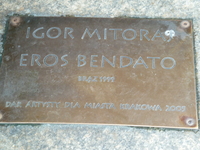 and then considered the sculpture
and then considered the sculpture
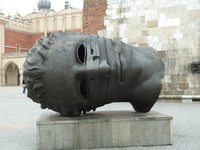 as it related to the town hall
as it related to the town hall
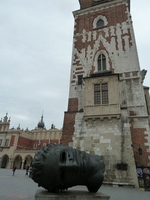 and as Suzanne read about the sculpture
and as Suzanne read about the sculpture
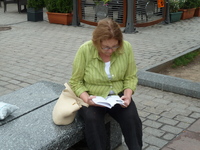 this man offered to give us a tour of the town. We got directions from him
this man offered to give us a tour of the town. We got directions from him
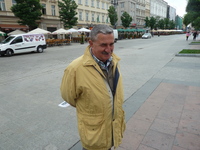 and then focused on artistic shots into
and then focused on artistic shots into
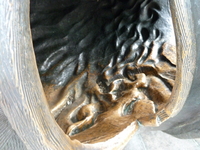 and through the sculpture (note Suzanne in the background)
and through the sculpture (note Suzanne in the background)
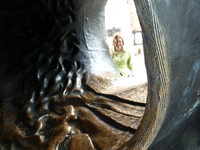 before recording St. Mary's church across the square
before recording St. Mary's church across the square
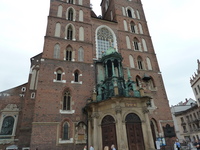 amid the flower markets
amid the flower markets
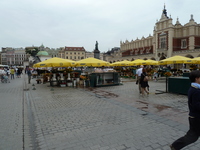 and began what would amount to a few pictures of alkohole stores (because the concept seemed so odd to us)
and began what would amount to a few pictures of alkohole stores (because the concept seemed so odd to us)
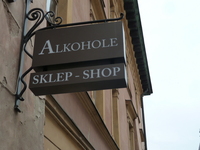
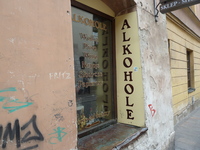 but we were looking for the Barbican and so this sign was quite helpful
but we were looking for the Barbican and so this sign was quite helpful
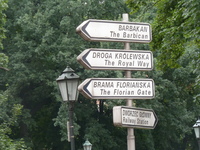 but not as amusing as this bike's owner who had left it in bubble blowing mode
but not as amusing as this bike's owner who had left it in bubble blowing mode
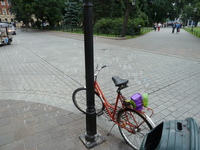 as we passed another alkohole
as we passed another alkohole
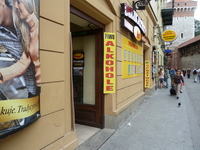 and found our way to the Barbican
and found our way to the Barbican
 which was worth a picture
which was worth a picture
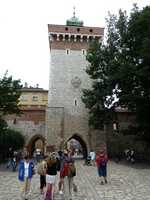 and we took another of the Black Mariah
and we took another of the Black Mariah
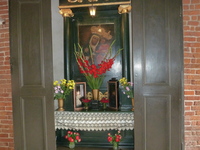 as we headed back to purchase a singing bird from this gentleman
as we headed back to purchase a singing bird from this gentleman
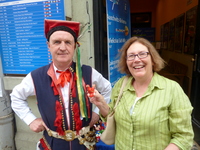 but chose not to eat fresh
but chose not to eat fresh
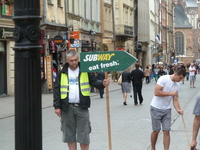 because we knew that after passing the hip-hop stuff
because we knew that after passing the hip-hop stuff
 we'd want one of the street bagel-like objects
we'd want one of the street bagel-like objects
 which we got and devoured
which we got and devoured
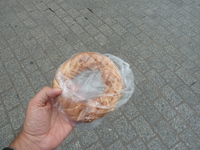 leaving virtually nothing for the pigeons
leaving virtually nothing for the pigeons
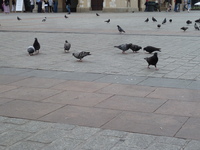 though Suzanne did use the occasion to shop in the Cloth Hall
though Suzanne did use the occasion to shop in the Cloth Hall
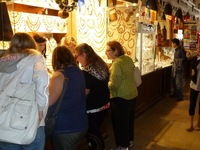
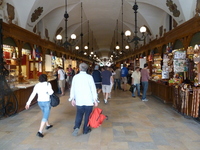 while I watched the crowds and took the obligatory phone booth picture
while I watched the crowds and took the obligatory phone booth picture
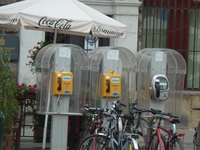 before we marched on to my new found friend
before we marched on to my new found friend

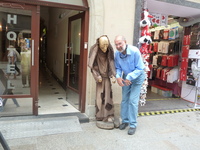
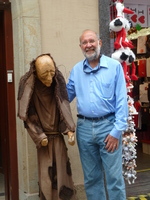 and then on to Wawel castle
and then on to Wawel castle

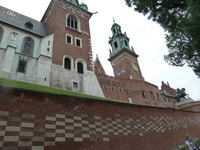 where we followed the ramp up the hill
where we followed the ramp up the hill
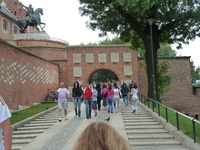 noting the Poles who had contributed
noting the Poles who had contributed
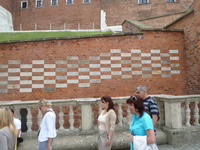 and then made our way through the gate
and then made our way through the gate
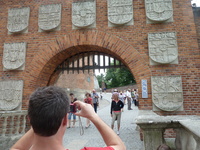
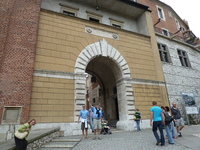 into the outer courtyard
into the outer courtyard
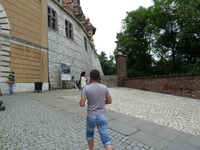
 for views of the cathedral
for views of the cathedral
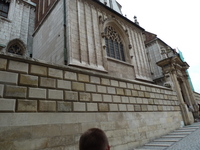
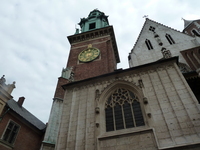 and then of this statue
and then of this statue
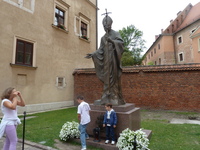 and the broad area
and the broad area
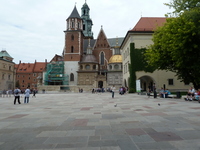 as we made our way through the passage
as we made our way through the passage
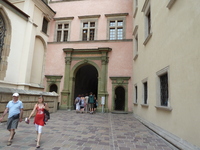 to the inner courtyard
to the inner courtyard
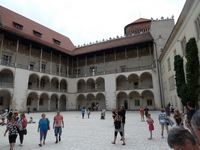

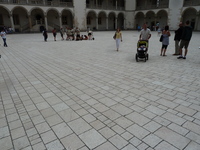 where I stood in the place of the chakras but did not transcend
where I stood in the place of the chakras but did not transcend
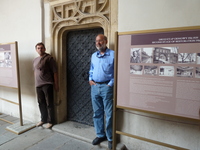
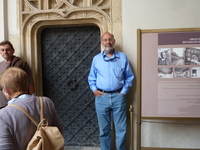 and next we studies the model of the entire castle area
and next we studies the model of the entire castle area
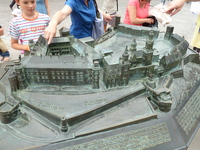 while going off to view the Vistula below
while going off to view the Vistula below
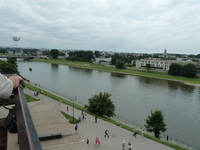
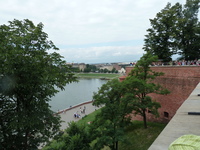
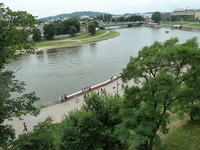 and catching the smallest view of the dragon slain by Prince Krak who founded the city.
and catching the smallest view of the dragon slain by Prince Krak who founded the city.
 Next we walked down the path
Next we walked down the path
 to the shops by the river
to the shops by the river
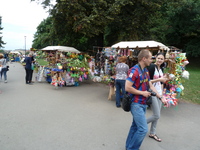 and found the dragon
and found the dragon
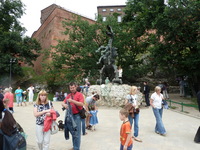
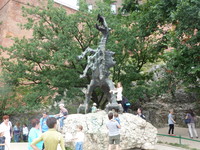

 who breathed fire for us.
who breathed fire for us.
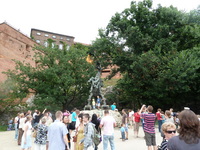
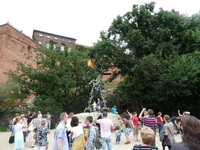
 On our way away from the dragon we walked the path of fame and noted that Michael Jackson is important here as well
On our way away from the dragon we walked the path of fame and noted that Michael Jackson is important here as well
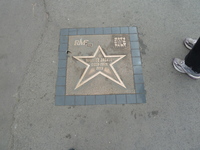 and we admired the river setting
and we admired the river setting
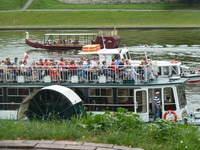
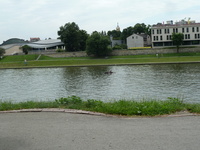 not to mention another alkohole
not to mention another alkohole
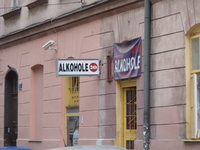 as we made our way to the painted car in the outsider art district
as we made our way to the painted car in the outsider art district
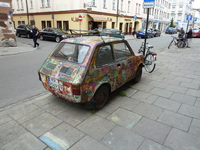 and took pictures of the shop owner from whom we purchased.
and took pictures of the shop owner from whom we purchased.
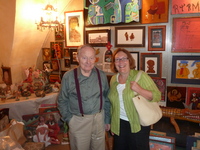
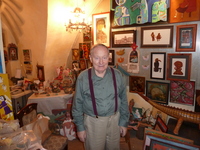 Next we made our way to the square with the round building where the zapiekanka's are sold
Next we made our way to the square with the round building where the zapiekanka's are sold
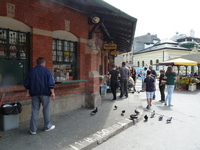 and joined the line
and joined the line
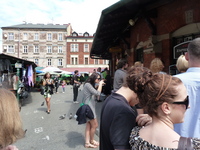 so that I could order mine with corn
so that I could order mine with corn
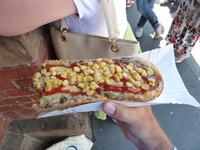
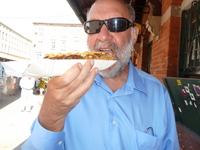 and Suzanne could order hers with salami and cheese.
and Suzanne could order hers with salami and cheese.
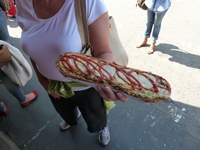
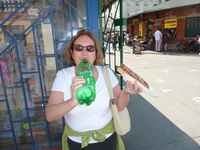 All of this activity made us thirsty and so we stopped at a cafe and had some beer
All of this activity made us thirsty and so we stopped at a cafe and had some beer
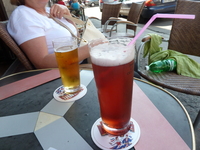 where I decided to start collecting the license plates of the world starting with Poland.
where I decided to start collecting the license plates of the world starting with Poland.
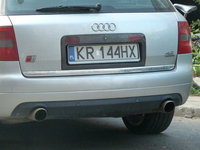 as we walked away, I noted this Jewish style restaurant
as we walked away, I noted this Jewish style restaurant
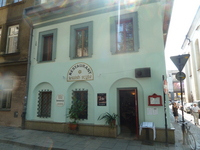 this poster for the Jewish festival
this poster for the Jewish festival
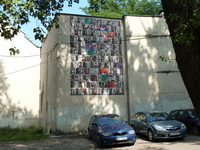 and this hotel offering a unique array of services
and this hotel offering a unique array of services
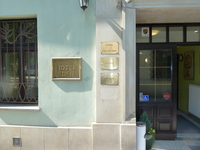 all the while capturing license plates of the Netherlands
all the while capturing license plates of the Netherlands
 and Germany.
and Germany.
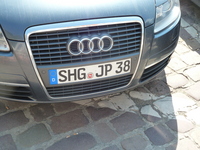
For dinner, we went to the very elegant Pod Aniotami restaurant
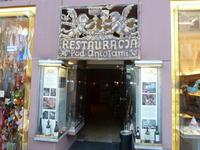 where this was the place setting
where this was the place setting
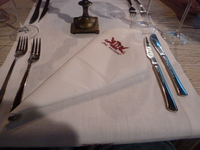 as Suzanne was illuminated by candle
as Suzanne was illuminated by candle
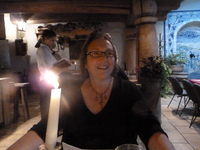 as we studied the menu
as we studied the menu

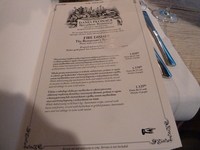
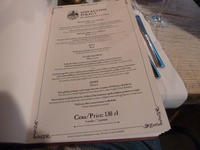 and note the mosaic fountain where one can make a wish to return (we didn't feel so inspired)
and note the mosaic fountain where one can make a wish to return (we didn't feel so inspired)
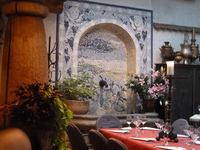 and I ordered this glass of sweet vodka
and I ordered this glass of sweet vodka
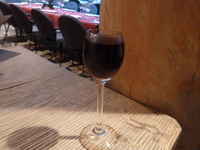 as Suzanne had her glass of wine
as Suzanne had her glass of wine
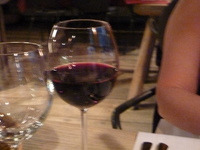 and lard was brought as a treat
and lard was brought as a treat
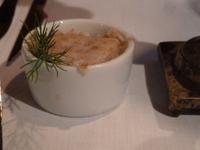 as we dined on pickles
as we dined on pickles
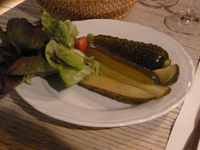 a shared salad
a shared salad
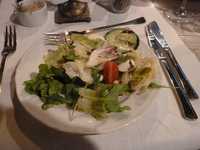 bass for Suzanne
bass for Suzanne
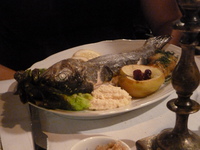 and a tasty mixture of chantrelle mushrooms and gnocchi for me.
and a tasty mixture of chantrelle mushrooms and gnocchi for me.
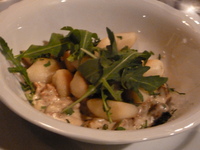 To end the evening, we stopped at a cafe by the main square and Suzanne had her tea
To end the evening, we stopped at a cafe by the main square and Suzanne had her tea
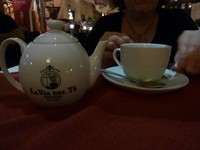 while I had my ice cream dessert.
while I had my ice cream dessert.

It was our last day in Krakow and so we took a walk to Kazmierz and noted an Alkohole (they all seem to be open 24/7)
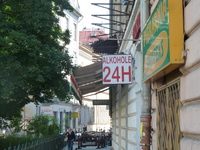 and what they sell
and what they sell
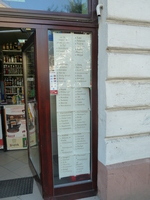 and then we headed to the flea market which was massive and impressive but we were not in the market for used clothing and its utility was limited.
and then we headed to the flea market which was massive and impressive but we were not in the market for used clothing and its utility was limited.
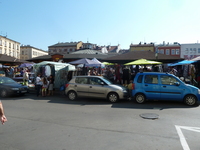
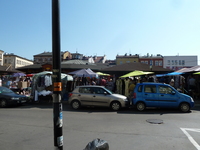 I found some license plates for that collection
I found some license plates for that collection
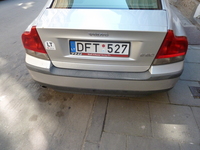
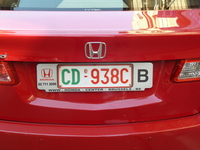 and then we came to an intersection with an alkohole in each direction
and then we came to an intersection with an alkohole in each direction
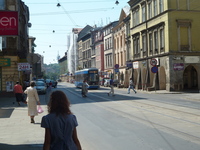 which was followed by the obligatory phone booth picture
which was followed by the obligatory phone booth picture
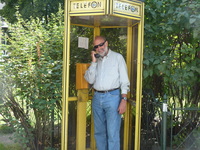
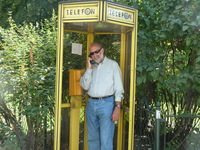 and then we headed back to the Hotel Alef which we loved and noted their rationale
and then we headed back to the Hotel Alef which we loved and noted their rationale
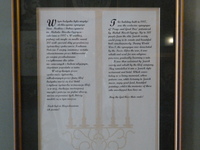 and took a last walk in the planty and captured this sign.
and took a last walk in the planty and captured this sign.
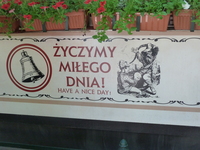 We thought that leaving Krakow would be easy but the taxi driver left us off at the international terminal and we were flying to Warsaw and so we had to walk 10 minutes to get to the right terminal
We thought that leaving Krakow would be easy but the taxi driver left us off at the international terminal and we were flying to Warsaw and so we had to walk 10 minutes to get to the right terminal
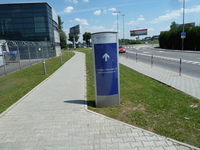 but when we arrived we found a license plate for my new found collection.
but when we arrived we found a license plate for my new found collection.
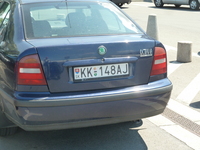 Unfortunately, our flight from Warsaw to Budapest had been canceled and so we were routed through Vienna which meant we had to do the 10 minutes walk next in reverse.
Unfortunately, our flight from Warsaw to Budapest had been canceled and so we were routed through Vienna which meant we had to do the 10 minutes walk next in reverse.
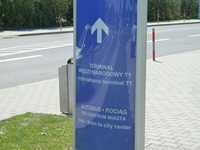 Because the new flight left later (and arrived earlier) we had time for a last lunch in Poland
Because the new flight left later (and arrived earlier) we had time for a last lunch in Poland
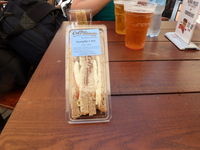
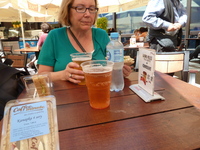
|
 with recycling bins
with recycling bins
 and a blurry sign in English
and a blurry sign in English
 with a clearer one in Polish though the agent would tell us there was a delay but wouldn't tell us why or when
with a clearer one in Polish though the agent would tell us there was a delay but wouldn't tell us why or when
 though we eventually made it onto the plane
though we eventually made it onto the plane

 and got our edible bar
and got our edible bar
 before getting to the other side and watching our baggage roll down the conveyor
before getting to the other side and watching our baggage roll down the conveyor
 so that we could catch the taxi to our hotel and pass this large hotel
so that we could catch the taxi to our hotel and pass this large hotel
 before we arrived
before we arrived
 and found our way to the room where the beds were typical
and found our way to the room where the beds were typical

 but the room was vase and the walls were covered with artwork
but the room was vase and the walls were covered with artwork



 and the bathroom looked good (and more so in the morning when we realized how wonderful the shower was).
and the bathroom looked good (and more so in the morning when we realized how wonderful the shower was).












































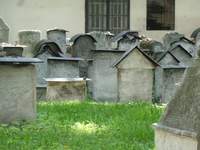
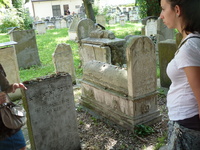
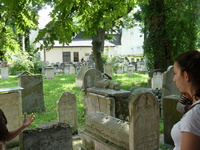
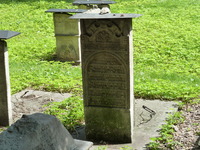
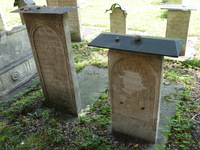
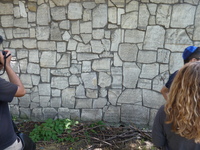
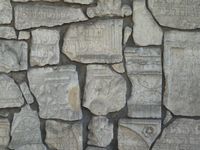
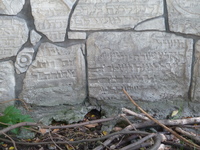
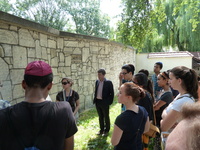

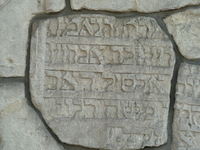


 and then saw some pieces of stones corresponding to Kahanim (and hence the hands).
and then saw some pieces of stones corresponding to Kahanim (and hence the hands).

 on the way out, I recorded this sad memorial
on the way out, I recorded this sad memorial
 and we headed to the town's memorial to the Jews who had perished
and we headed to the town's memorial to the Jews who had perished

 and the square (which is now filled with shops and restaurants largely owned by non-Jews)
and the square (which is now filled with shops and restaurants largely owned by non-Jews)
 and the synagogue
and the synagogue
 before capturing a final shot of the memorial
before capturing a final shot of the memorial
 and heading across the river to this plaza where the chairs had a special significance as I was to learn
and heading across the river to this plaza where the chairs had a special significance as I was to learn
 but first I noted this street scene which was the location of the resistance
but first I noted this street scene which was the location of the resistance
 as our group came onto the square which was at the heart of the ghetto
as our group came onto the square which was at the heart of the ghetto

 as we left this structure which had served as the police station for the Nazis who oversaw the ghetto
as we left this structure which had served as the police station for the Nazis who oversaw the ghetto
 and it was here that I learned that the chairs were an art installation dedicated to those who had been killed by the Nazis
and it was here that I learned that the chairs were an art installation dedicated to those who had been killed by the Nazis

 and we then walked down the street
and we then walked down the street
 and took the obligatory phone booth picture
and took the obligatory phone booth picture
 before we came to this sign
before we came to this sign
 defining the ghetto wall which had been made to look like tombstones to signify tot he Jews that this was their end.
defining the ghetto wall which had been made to look like tombstones to signify tot he Jews that this was their end.


 We were also shown windows that were bricked over as they were on buildings that were part of the ghetto and so could not have views to the outside
We were also shown windows that were bricked over as they were on buildings that were part of the ghetto and so could not have views to the outside
 and as we walked
and as we walked
 this sign seemed like an odd juxtaposition of the past and the present (or future)
this sign seemed like an odd juxtaposition of the past and the present (or future)
 and so we made our way to Oskar Schindler's factory
and so we made our way to Oskar Schindler's factory
 and saw the names of those he had saved
and saw the names of those he had saved


 before entering the museum
before entering the museum
 noting the price guide
noting the price guide
 and having some water, it being a hot day,
and having some water, it being a hot day,
 and seeing the kosher statement (which had just expired) for the coffee.
and seeing the kosher statement (which had just expired) for the coffee.







































































































































































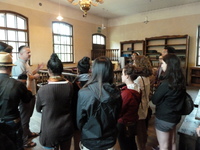
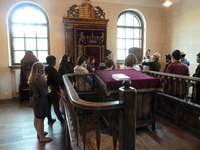
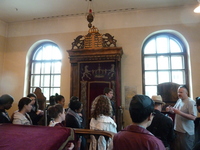
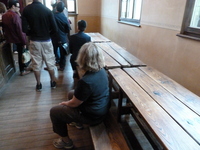
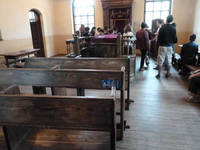
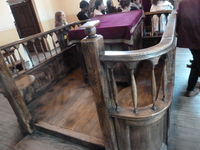
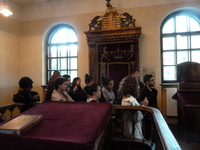











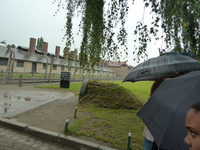


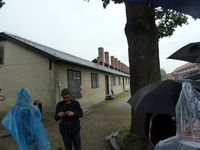
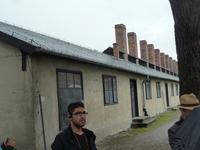

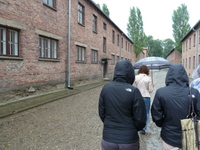
 of where people came from to Auschwitz
of where people came from to Auschwitz
 and their numbers
and their numbers
 along with some of the horrible rationale that was used to justify the place.
along with some of the horrible rationale that was used to justify the place.

 We watched people arrive
We watched people arrive
 saw this memorial
saw this memorial
 and read some of the history
and read some of the history



 and saw the Jews leaving various transit camps and ghettos
and saw the Jews leaving various transit camps and ghettos

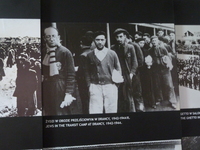

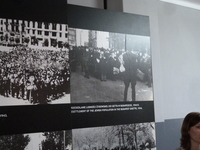

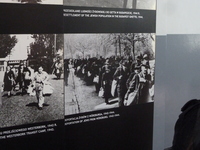
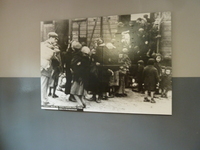
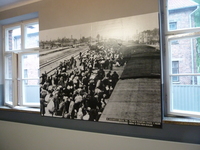
 as we revisited the state borders at the time
as we revisited the state borders at the time
 watched families arrive
watched families arrive
 and heard the tale people were told on arrival to get them into the gas chambers
and heard the tale people were told on arrival to get them into the gas chambers
 and observed a model of an actual crematorium.
and observed a model of an actual crematorium.

 These were the canisters that he;d the poisonous gas
These were the canisters that he;d the poisonous gas
 this was the scale of the operation
this was the scale of the operation
 and these were individual pellets that killed.
and these were individual pellets that killed.
 Personal affects were gathered as were these eye glasses
Personal affects were gathered as were these eye glasses
 these tallises
these tallises

 these prosthetics
these prosthetics
 these pots and pans (since people thought they were being relocated)
these pots and pans (since people thought they were being relocated)
 the luggage they brought
the luggage they brought

 toys for the children
toys for the children
 and shoes
and shoes


 as the rain fell outside and the day was dark as was appropriate for our tour.
as the rain fell outside and the day was dark as was appropriate for our tour.

 Next we were shown barracks that housed up to 1000 people
Next we were shown barracks that housed up to 1000 people
 with photos of those interred until the cost of photography became too great and so numbers were tattooed on arms to track prisoners
with photos of those interred until the cost of photography became too great and so numbers were tattooed on arms to track prisoners
 and initial sleeping conditions which was hay on floors
and initial sleeping conditions which was hay on floors
 with this row of sinks which could be used for few minutes per day per person
with this row of sinks which could be used for few minutes per day per person
 and this describes
and this describes
 the later (more improved) sleeping arrangements.
the later (more improved) sleeping arrangements.
 Needless to say the living conditions were horrible
Needless to say the living conditions were horrible
 as were these structures onto which prisoners crowded.
as were these structures onto which prisoners crowded.
 Next we made our way
Next we made our way
 and saw the guards' box
and saw the guards' box
 where the SS officer in charge would stand if it was raining and there were escapees and so the prisoners had to stand outside for as long as 21 hours until the escapees returned (or were killed)
where the SS officer in charge would stand if it was raining and there were escapees and so the prisoners had to stand outside for as long as 21 hours until the escapees returned (or were killed)
 and we saw the gallows
and we saw the gallows
 where those involved in escapes (including this group) were hung
where those involved in escapes (including this group) were hung
 and we made our way past the barbed wire fences
and we made our way past the barbed wire fences

 to the place where the first commandant was hung after the war.
to the place where the first commandant was hung after the war.
 Next we made our way into the actual gas chambers. At this spot you removed your clothes.
Next we made our way into the actual gas chambers. At this spot you removed your clothes.
 and went into what you thought was a shower room
and went into what you thought was a shower room
 but many were killed there and must be respected
but many were killed there and must be respected
 for a guard dropped pellets through holes like this in the roof which killed everyone in the room
for a guard dropped pellets through holes like this in the roof which killed everyone in the room
 and then the bodies were placed in ovens such as these to be reduced to ashes which were used to fertilize the soil.
and then the bodies were placed in ovens such as these to be reduced to ashes which were used to fertilize the soil.

 We walked away from the train tracks at Auschwitz 1
We walked away from the train tracks at Auschwitz 1


 and went to Auschwitz 2 -- Birkenau which was designed to kill many more people
and went to Auschwitz 2 -- Birkenau which was designed to kill many more people
 as the grounds were enormous
as the grounds were enormous



 and more primitive
and more primitive
 as you can see from the beds on which people slept
as you can see from the beds on which people slept

 in a massive room that had previously been a barn
in a massive room that had previously been a barn
 which housed 52 horses and now was housing 400 prisoners.
which housed 52 horses and now was housing 400 prisoners.
 Next we saw the bathroom facilities
Next we saw the bathroom facilities
 where the toilet were unsanitary, not private and of use for very limited time.
where the toilet were unsanitary, not private and of use for very limited time.
 Finally we climbed up into the tower so that we could see just how massive the camp was.
Finally we climbed up into the tower so that we could see just how massive the camp was.
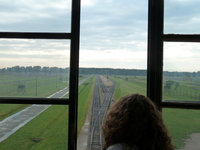
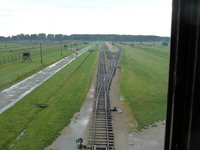
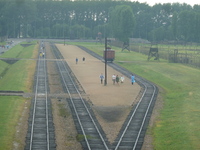
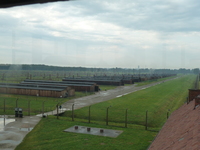
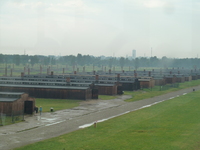
 and that this has been named a world heritage site so that all will know what happened here.
and that this has been named a world heritage site so that all will know what happened here.
 After a few more photos from outside noting the vastness
After a few more photos from outside noting the vastness


 we headed back to Krakow where I said good bye (though this would happen again) to Barry and his wife
we headed back to Krakow where I said good bye (though this would happen again) to Barry and his wife
 and we got some food for a snack before dinner.
and we got some food for a snack before dinner.
 Then we went out to dinner and had borscht
Then we went out to dinner and had borscht
 and hummus (along with pierogies)
and hummus (along with pierogies)
 and the borscht was too pretty to not record.
and the borscht was too pretty to not record.







































































































































